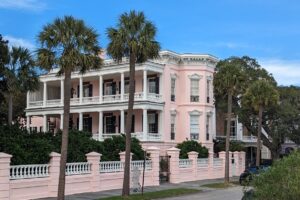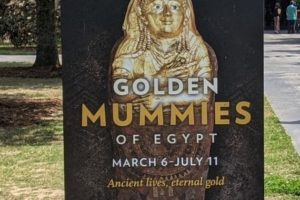Have you ever seen this emblem on a Ford truck? I have but never thought anything of it and never asked Barney about it. But as we were talking about what to do in Corpus Christi, he mentioned that the King Ranch was only about an hour away. Did I want to go? You bet. I couldn’t believe that there was really a King Ranch behind the logo on some trucks. (We went to the Tifton Ford dealer in Brownsville, and they let me take this picture from a truck on the lot.)

We went to the King Ranch Museum in town and saw the very first year that Ford partnered with King Ranch—the same year as our truck, 2001. It was fancier inside with its leather seats, but the controls were in the same place and looked like ours. Amazing. Now on to King Ranch.
Richard King was born in New York City, the youngest of some pretty poor parents. They indentured him to a jeweler, but when his job turned out to be a babysitter rather than a jeweler, he ran off and got aboard a steamer headed south. On this boat and others, he learned everything he could about steam ships and ended up being a captain on a ship. When he got to Brownsville, he partnered up with some other men and got rich transporting goods and people around the Gulf.

In 1853 he bought some land grants and started stocking longhorn cattle on property that was supported by the Santa Gertrudis Creek.

While he had the money and the land, he knew he needed good men to help him with the cattle. He convinced a group of men from a town in Mexico that was going through a hard time to move themselves and their families to this new ranch. They would be paid for their time, and King promised to provide them with housing and everything else they needed to be successful. He kept his word. Many of the men working at the ranch today are 7th generation workers; some have moved to town (Kingville), but many still live on the property. These are two of the nicer properties, and the older ones from the 1940s are being updated.
When King married Henrietta two years later and she moved to the ranch, she added her touch to the area. Mrs. King had been a school teacher so started teaching the workers’ children as well as her own (they had 5 children). Today a school for 3-year olds through first grade is still on the property, the grade and middle schools are in Kingville (and the ranch supports the school), and the high school is on the campus of Texas A&M in Kingsville so students can get college credit as they complete high school. Also, Texas A&M in Kingsville is the only university that has a masters degree program for cowboys—sponsored by the King Ranch so they can keep getting top-notch employees.

Mrs. King hated rattlesnakes and so started a drive to get rid of them.

Today the ranch covers 825,000 acres in 4 sections in Texas and has 90,000 acres in Florida. It’s one of the largest ranches in the United States. At its height, it had properties in 8 countries, but now it’s just in the U.S., making taxes a lot easier to handle
So what made the King Ranch so successful? First Mr. King concentrated on raising longhorn cattle and taking them to Kansas City to sell on cattle drives. As the population in the eastern part of the country was growing, the demand for beef had to keep up with it. These cattle drives were profitable.
But longhorn cattle don’t have much fat on them, even though they could tolerate the heat in south Texas. Mr. King decided to work on a new breed of cattle. He ended up breeding a Brahman bull from India that could tolerate heat but didn’t have fat for beef with an English shorthorn that couldn’t tolerate heat but had lots of good beef. The result was a breed of cow new to the United States called Santa Gertrudis after the creek on his property.

a mamma with her baby 
egrets hang eating insects that would bother the cattle
This breed is kept on all 4 divisions in Texas making up the King Ranch. The cows (and horses) are all brown since that’s the best color to protect them from sunburn.
Then Mr. King got into horse racing, and ended up with some national champions. They also bred thoroughbreds with quarter horses so the horses would have endurance, speed, and quickness when needed to move around the cattle. Now they just raise horses for use on the ranch and currently have around 200 quarter horses. Why are they called quarter horses? Because they can run fast for a quarter of a mile! Now the cowboys and cowgirls drive their trucks and pull a horse trailer behind. Much more efficient.

quarter horse 
gravestones for the national champions
See the turkeys? Lots of birds and animals call this ranch home. The fencing is high enough that small animals and birds can get under it and low enough that deer and other animals can jump over it. No barbed wire here. They love their animals but also provide hunting tours that are really popular and keep the animals healthy.

The land is maintained as open areas for grazing and protected areas for the heat of the day and storms.

Water is critical on the ranch. First they built ponds to collect rain water, then they used a process from a farmer in Nebraska to drill (way deep) for water. This is one of the water supply well for one of the properties. We’ve never been able to find out how they knew where to drill. Hmmm.

Of course oil was found on the ranch, and oil workers didn’t want to take the time to get out of their trucks to open gates and then close them. So they created these “bump gates.” A driver would only have to “bump” the fence and it would open up.

driver didn’t hit it just right, the gate would hit his truck.
Originally this was the commissary for the ranch since Mr. King had to provide everything for his workers and their families.

An original building built out of brick because of fire, it was the livery across the road from the commissary. You may have seen it in Ford ads.

Jan was our tour guide for the 90-minute drive around the ranch. She’s from the area and went to school with workers’ children. She said the workers on the ranch are some of the most hard working men she’s ever seen.










